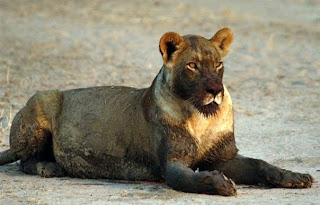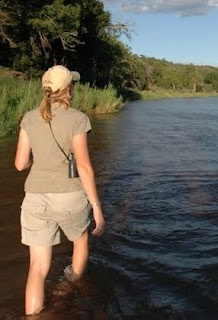



Although they all but share a kingdom, both the crocodiles and the hippos are prepared to cross boundaries if something is at stake. For the crocodiles it’s a matter of food, for the hippos, possibly a matter of kinship or simply a lack of cognitive understanding of death. Amidst the feeding chaos, the hippo’s own brave the hordes of shiny teeth and flailing tempers for an investigation. Barging through the ranks of crocodiles, biting, pushing…what are the rules?
Recognition is sought by the hippo through licks and sniffs and nudges. The opening of the mouth indicates the use of the vemoronasal organ (commonly called the Organ of Jacobsen) which detects airborne steroid hormones. Typically this organ is used in determining whether an individual is ready to mate but is also used in the recognition of individuals. Maybe the salts on the sun-baked skin are simply a dry season delicacy for those who survive to harvest it? The teeth of a hippo are not exactly designed to nibble meat off spongy carcasses but licking is certainly possible. Hippos are after all the descendents of pigs.
On a particular channel, the Changwa, there are so many hippos packed together in the shallow remaining water of a fast shrinking river that a photograph reveals 100 heads but no light or space between them…it’s an epic tin of sardines! Changwa especially becomes overcrowded as the water level drops, a giant super-pod of thriving bodies and bad tempers. The rerouting of the river here, in its relentless quest to change course and create oxbows, provided an apparently super-attractive spot of hippo real estate. The Changwa Pod is no ordinary pod of hippos, it’s a super-pod and they offer us an exaggerated look at the dynamics of hippo life in the Valley. Fights break out…disease attacks…heat exhaustion takes its toll and hippos die creating a feast of notable proportions for the 100’s of crocs in the river that pile into these carcasses in numbers up to 200 at a time. The crux comes when the lions find such carcasses on the waters edge and fight off the crocs in a unique predator standoff for sole access to the meat.
For most of the year, these species seldom clash. Lions dispatch all decaying finds on land, crocodiles keep the Luangwa’s waters clean. Not so at this time of year. It’s a free for all and a wealth of hippo meat is too good a find for both competitors and sharing is just not an option. Armed with enormous teeth, lightning fast reflexes and claws of steel, the crocodile is a force to be reckoned with. But although the crocodile is obstinate and has craftiness on its side, there is a chink in its armour. Ten times the size of a lions’ jaws perhaps, the crocodile’s jaws do not provide an enormous amount of crushing power. Success is in the surprise of the attack and thereafter the ability to latch, drown and twist to feed off their prey. If matched against the lions and hippo, the crocs are up against high odds when out of their own domain.
Moving straight in, the lioness drags the carcass inch at a time up the beach, gaining ground for the lions before the carcass is lightened enough to be fleet-footed into the water. The water means victory for the crocodiles and here the lions do fear to tread! The crocodiles crawl up the beach after their escaping meal. The lions have speed and muscular power on land but the crocs have overpowering numbers on their side.
The Luangwa Valley’s top predators come face to face in the ultimate showdown. Lions and crocodiles clash over the final rights to this ultimate dry season prize – a prize defended valiantly by its own kind!
























